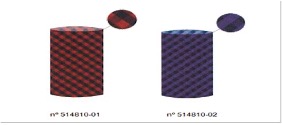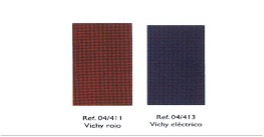BACKGROUND TO THE DISPUTE
ARTURO is the holder of registered industrial designs Nos. 514810-01 and 514810-02, consisting of applying the print of the “cachirulo aragonés” (handkerchief), in its two versions red-black / purple-black, to a tubular garment or neck brace.

Since 1995, the trading company ORIGINAL BUFF S.A. has been marketing multifunctional tubulars with similar characteristics under the names “red vichy” and “electric vichy”.

ORIGINAL BUFF filed an action against D. ARTURO, in which it brought an action for a declaration of invalidity in accordance with art. 65 of the Industrial Design Law (LDI) on the grounds that:
(i) that the registered designs, in position of use, produce the same overall impression as that produced by the typical scarf known as “cachirulo aragonés”.
(ii) the same product, with the same patterns, the same formal characteristics, the same structural characteristics and the same visual information was already marketed previously by the applicant.
The defendant opposed the action. It argued that its designs are not simply tubular warm garments, but modernise and update the traditional “cachirulo”. The protected novelty lies in the application of the traditional “cachirulo” print, in its two colour versions, to a specific shape – elastic tubular collar cuffs – which makes the design, as a whole, novel.
The judgment at first instance dismissed the action. It assessed the characteristics of novelty and uniqueness of the contested designs. As regards the pattern of the traditional scarf, because the tubular shape gave a new combination of colours, shape and texture. And as regards the anticipation of the goods since 1995, on the ground that there were relevant differentiating elements.
The appeal lodged by the applicant was dismissed by the Provincial Court. It held that:
(i) there is novelty due to the combination of the typical colours of the “cachirulo” with a shape that is also known, but by introducing differences that do not produce in the informed user the same general impression.
(ii) the comparison between the two products, since the elastic brief does not have to be knotted, produces a clearly different combination of pattern and shape.
ORIGINAL BUFF brought an appeal in cassation. The sole ground of appeal alleges infringement of Article 7 of Law 20/2003. The appellant alleges that the judgment under appeal does not apply the case-law criterion that the assessment of the overall impression that a design produces on the informed user must be carried out taking into account the manner of use of the product represented by that design. In particular, it fails to take account of the fact that, if the Aragonese “cachirulo” is compared with the products resulting from the defendant’s designs in a position of use, the overall impression is no different.
Article 7 of the IDL, under the heading “Unique character “, states the following:
- “A design shall be deemed to have a unique character when the overall impression in the informed user, differs from the overall impression produced in that user by any other design that has been made available to the public before the filing date of the application for registration or, if priority is claimed, before the priority date.
- Determining whether the design has a unique character shall take into account the author’s degree of freedom to develop the design.”
The notion of industrial design is defined as the appearance of the whole or part of a product and is granted protection not only for the mere subjective fact of its creation, but it is also required that this appearance implies a relevant and enriching contribution to the previous state of aesthetic industrial creations, from the objective perspective of its commercial value due to its application to a business activity.
DECISION OF THE COURT
The Provincial Court summarises the uniqueness of the defendant’s designs and considers that the general impression of an informed user is different due to the fact that, while the scarf (“cachirulo”) has to be tied, the tubular briefs do not. And with regard to the tubulars, it finds that the differences resulting from the different size of the frames and their oblique rather than horizontal arrangement produce a different overall impression.
The appeal questions the uniqueness of the design (the neck warmer with the print of the cachirulo scarf) precisely because of the existence of that print in “cachirulo” scarves, and it is therefore appropriate to compare the design with the “cachirulo” (or “cachirulos”, because as we have seen there are two prints).
For there to be uniqueness, the subsequent design must be reasonably divergent from the previous designs, so that, although a high degree of distinctiveness is not required, a minimal or anecdotal differentiation that allows protection to be obtained for designs that only differ from the previous ones in minimal or practically insignificant details is not allowed either.
In this case, the mere application of an already known pattern, such as the “cachirulo”, to a different garment does not in itself give the design a unique character, which remains the same (lack of novelty) or similar (with some variants), as long as it does not create a different overall impression to that of the “cachirulo” pattern for an informed user of the products in which the registered design is incorporated.
The legal property protected is the added value that the design gives to the product and which coincides with the commercial interest it arouses. The scope of protection, for its part, extends to any other design that does not produce in the informed user a general impression different from that produced by the protected design, taking into account the degree of freedom of the author when creating the design.
In this case, the “brachirulo” lacks individual character, on the basis that the print, although not exactly the same as that of the “cachirulo”, does not produce a different overall impression, even taking into account the difference in use as a scarf or as a tubular knicker.
The same pattern applied to a scarf would not be unique, so that, if the overall impression is not different from that of the neckerchief, there would also be no uniqueness when the pattern is applied to a neckerchief, as long as it does not produce a different overall impression on the informed user of these goods.
It can therefore be concluded that the change of product does not necessarily in itself give a unique character to the same well-known pattern, as long as it does not create a different overall impression on the informed user. The appeal must therefore be upheld. Consequently, the appeal must also be upheld and the claim upheld in its entirety, declaring the registered designs in question to be invalid, in view of their lack of individuality and novelty.
Supreme Court, First Civil Chamber, Judgment 608/2021 of 16 Sep. 2021, Rec. 2723/2018.


 Español
Español Deutsch
Deutsch